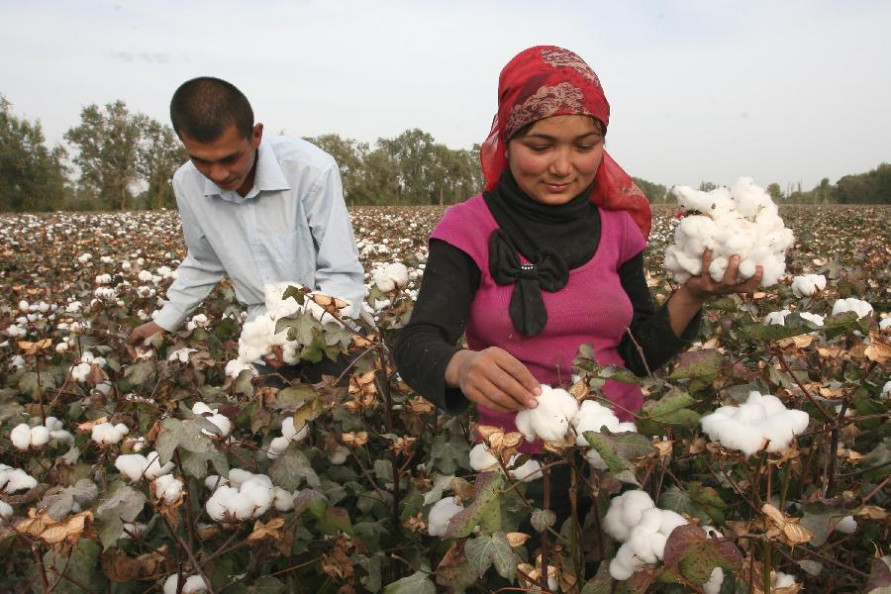By Mandy Zuo
One year after a US import ban was implemented, China has grown less cotton in its Xinjiang Uygur autonomous region, with a significant drop in output expected this year amid a quality push and food security drive.
China, which provides over 20 per cent of the world’s cotton, mostly from the western region of Xinjiang, may see its production fall by more than 10 per cent as it places an emphasis on quality over quantity and makes room for crops, according to analysts and farmers.
Climate shocks over the past few months are also likely to contribute to decreased yields in the region, whose products are being redirected to countries that are part of China’s Belt and Road Initiative following a US-led boycott for alleged forced labour. Beijing has consistently denied the allegations.
The government has been committing to high quality development of the cotton industry for years
Beijing Cotton Outlook Consulting
The US’ Uygur Forced Labour Prevention Act, which went into effect in June 2022, has effectively blocked American imports of all products wholly or partially sourced from Xinjiang.
“The government has been committing to high quality development of the cotton industry for years, and achieved visible progress in the past year, as fields believed not to be best for the growth of cotton are switched to other crops,” said a statement from Beijing Cotton Outlook Consulting.
She expects output in Xinjiang to fall by 11 per cent in 2023 from last year to 5.57 million tonnes, while China’s overall output is expected to fall by 11.8 per cent from 2022 to 5.98 million tonnes.
A directive by the sprawling Xinjiang Production and Construction Corps in July said 16 of its divisions would stop growing cotton by the end of the year in a bid to “prioritise planting structure and improve quality”.
Critical grains cut back China’s copious cotton yields amid food-security push
“In the past we could grow cotton on all the 8,000 mu (1,320 acres) of land, but now this is not allowed,” said Jin Suifeng, who runs a farmers’ cooperative in Tiemenguan in southern Xinjiang.
“Between 2,000 and 3,000 mu is now used to grow food crops as demanded, although cotton is apparently more profitable than grains.”
Zhang Wenjun, another farmer who leads a cooperative in Hoboksar county in northern Xinjiang, said there were 87,000 mu of cotton fields last year in his township, but this year it has dropped by 10,000 mu.
“Now, the authorities encourage us to grow grains, not cotton,” he said.
Beijing has ramped up efforts in recent years to increase grain production amid concerns over food security, including a nationwide campaign to reclaim farmland and adjust the crops that are sowed.
The shrinking cotton acreage is also in line with the global trend as farmers opt to grow less after an increase in costs and fall in prices reduced profits last year, added Beijing Cotton Outlook Consulting.
Xu Yaguang, an agricultural analyst from Guolian Futures, estimated that Xinjiang’s cotton sowing acreage may drop by 8.5 per cent, while the yield per unit could fall by 5 per cent.
Extreme weather, including heavy wind and rain, in the spring and a month-long heatwave in the past month, may contribute to a fall in yield in parts of Xinjiang.
“How the output turns out eventually will depend on weather in the coming weeks,” Xu said.
China’s retail sales in July pointed to the largest fall so far this year, but operating rates at spinning factories – an indicator of the industry’s prosperity – remain quite high, Beijing Cotton Outlook Consulting noted.
In terms of exports, China also saw a plunge in textile and apparel shipments in July, which the consulting firm attributed to weak demand in Europe and North America, which are traditional destinations for China’s cotton products.
“Garment companies in these regions had stocked up on Chinese goods before the Xinjiang cotton ban, so they’re not short of supplies while sales remained sluggish,” they added.
Europe and North America used to be the major market for our high-end yarn, but now it’s going to domestic factories
With Europe and North America favouring the likes of India and Vietnam, China has responded by focusing on its domestic market, while also redirecting its exports to Belt and Road Initiative members, she said.
“The demand for Chinese cotton is unlikely to increase as a result, but there’s not much room for further decrease either,” she said.
China’s domestic market consumes 8 million tonnes of cotton each year, which means it also needs to supplement its supply with imports.
“Europe and North America used to be the major market for our high-end yarn, but now it’s going to domestic factories or those in the Middle East and Africa, where they are sold at a lower price. Therefore profits are becoming smaller,” said Tiemenguan farmer Jin.
Boon or burden? Asian alternatives to Xinjiang cotton find US ban challenging
Last year, profits at textile and apparel companies with annual revenue of 20 million yuan (US$2.76 million) or more dropped by 1.1 per cent and 4.6 per cent, respectively from the previous year due to high costs and low demand, according to an annual report from the China National Textile and Apparel Council.
China has been losing its global market share in apparel, according to the World Trade Organization’s “World Trade Statistical Review 2023”.
Apparel exports from China accounted for 31.7 per cent of the world’s total by value last year, down from around 38 per cent during the 2015-18 period, the review showed.
Despite remaining as the world’s leading apparel exporter, shipments from China grew by just 3.6 per cent by value last year, lower than the 5 per cent global average growth, it added.


